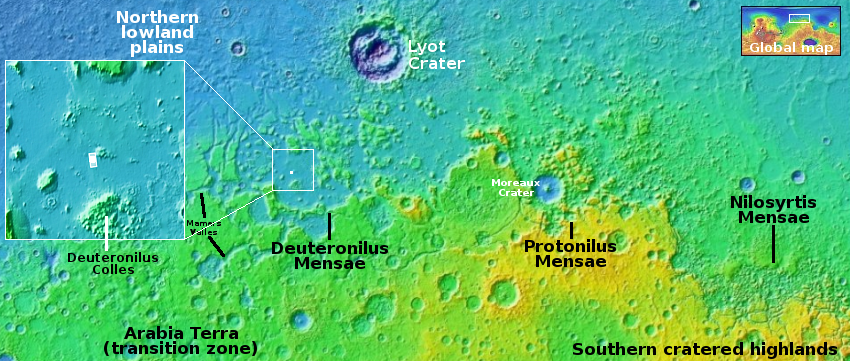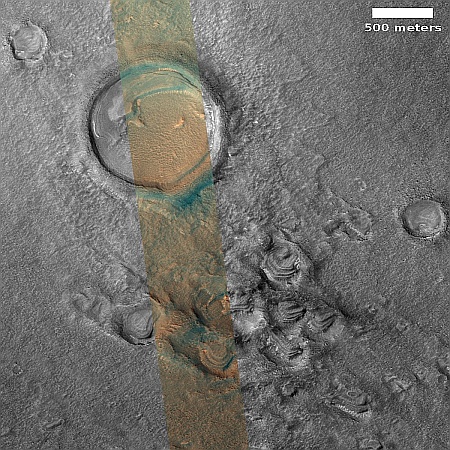Strange mesas in the glacier country of Mars

Cool image time! The picture to the right, cropped, reduced, and sharpened to post here, was taken on October 2, 2024 by the high resolution camera on Mars Reconnaissance Orbiter (MRO). The white dot in the overview map above marks the location, inside the chaos terrain of Deuternilus Mensae and part of the 2,000-mile-long mid-latitude Martian strip I label “glacier country,” because practically every image of every part of its landscape has glacial features. For example, the splash apron around the picture’s largest crater as well as the material within it all suggest some form of glacial activity and near-surface ice.
The scientists label what they see here as “Mesas in Small Craters.” These features are located in a low flat plain that geologists think was created when the ground eroded away, leaving behind scattered high plateaus that indicate the previous surface elevation. The geological map [pdf] of this plain describes it as follows:
Smooth, relatively featureless materials with regions of variable albedo north of continuous cratered highlands; exhibits scattered clusters of small circular to irregular knobs.
Based on the many accumulated photos from MRO, the general conclusion is that we are looking at a sheet of ice/dirt and covered by a thin dust layer that acts to protect that ice from sublimating away. When wind blows that dust off and the summer sun hits that near-surface ice, however, it does sublimate in bursts, which thus provides an explanation for the erosion that caused these low featureless plains.
As for these strange terraced mesas inside these distorted hollows, my guess is that the mesas predate the icesheet and are made of material with less ice impregnated within it. As that ice sublimates away it creates the craters within which the mesas remain. The terraces suggest a earlier series of geological sedimentary history.
On Christmas Eve 1968 three Americans became the first humans to visit another world. What they did to celebrate was unexpected and profound, and will be remembered throughout all human history. Genesis: the Story of Apollo 8, Robert Zimmerman's classic history of humanity's first journey to another world, tells that story, and it is now available as both an ebook and an audiobook, both with a foreword by Valerie Anders and a new introduction by Robert Zimmerman.
The print edition can be purchased at Amazon or from any other book seller. If you want an autographed copy the price is $60 for the hardback and $45 for the paperback, plus $8 shipping for each. Go here for purchasing details. The ebook is available everywhere for $5.99 (before discount) at amazon, or direct from my ebook publisher, ebookit. If you buy it from ebookit you don't support the big tech companies and the author gets a bigger cut much sooner.
The audiobook is also available at all these vendors, and is also free with a 30-day trial membership to Audible.
"Not simply about one mission, [Genesis] is also the history of America's quest for the moon... Zimmerman has done a masterful job of tying disparate events together into a solid account of one of America's greatest human triumphs."--San Antonio Express-News

Cool image time! The picture to the right, cropped, reduced, and sharpened to post here, was taken on October 2, 2024 by the high resolution camera on Mars Reconnaissance Orbiter (MRO). The white dot in the overview map above marks the location, inside the chaos terrain of Deuternilus Mensae and part of the 2,000-mile-long mid-latitude Martian strip I label “glacier country,” because practically every image of every part of its landscape has glacial features. For example, the splash apron around the picture’s largest crater as well as the material within it all suggest some form of glacial activity and near-surface ice.
The scientists label what they see here as “Mesas in Small Craters.” These features are located in a low flat plain that geologists think was created when the ground eroded away, leaving behind scattered high plateaus that indicate the previous surface elevation. The geological map [pdf] of this plain describes it as follows:
Smooth, relatively featureless materials with regions of variable albedo north of continuous cratered highlands; exhibits scattered clusters of small circular to irregular knobs.
Based on the many accumulated photos from MRO, the general conclusion is that we are looking at a sheet of ice/dirt and covered by a thin dust layer that acts to protect that ice from sublimating away. When wind blows that dust off and the summer sun hits that near-surface ice, however, it does sublimate in bursts, which thus provides an explanation for the erosion that caused these low featureless plains.
As for these strange terraced mesas inside these distorted hollows, my guess is that the mesas predate the icesheet and are made of material with less ice impregnated within it. As that ice sublimates away it creates the craters within which the mesas remain. The terraces suggest a earlier series of geological sedimentary history.
On Christmas Eve 1968 three Americans became the first humans to visit another world. What they did to celebrate was unexpected and profound, and will be remembered throughout all human history. Genesis: the Story of Apollo 8, Robert Zimmerman's classic history of humanity's first journey to another world, tells that story, and it is now available as both an ebook and an audiobook, both with a foreword by Valerie Anders and a new introduction by Robert Zimmerman.
The print edition can be purchased at Amazon or from any other book seller. If you want an autographed copy the price is $60 for the hardback and $45 for the paperback, plus $8 shipping for each. Go here for purchasing details. The ebook is available everywhere for $5.99 (before discount) at amazon, or direct from my ebook publisher, ebookit. If you buy it from ebookit you don't support the big tech companies and the author gets a bigger cut much sooner.
The audiobook is also available at all these vendors, and is also free with a 30-day trial membership to Audible.
"Not simply about one mission, [Genesis] is also the history of America's quest for the moon... Zimmerman has done a masterful job of tying disparate events together into a solid account of one of America's greatest human triumphs."--San Antonio Express-News


